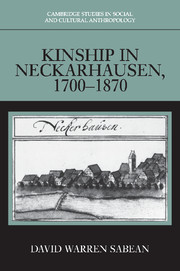Book contents
- Frontmatter
- Contents
- List of tables
- Abbreviations
- Abbreviations of sources
- On reading kinship diagrams
- Glossary
- Preface
- Introduction
- Cohort I (1700–1709)
- Cohort II (1740–1749)
- Cohort III (1780–1789)
- Cohort IV (1820–1829)
- Cohort V (1860–1869)
- Conclusion
- 20 Neckarhausen in European comparative perspective
- 21 Consanguinity in modern Europe
- 22 Kinship and class formation
- 23 Kinship and gender
- Appendix
- Bibliography
- General index
- Index of villagers
20 - Neckarhausen in European comparative perspective
Published online by Cambridge University Press: 04 August 2010
- Frontmatter
- Contents
- List of tables
- Abbreviations
- Abbreviations of sources
- On reading kinship diagrams
- Glossary
- Preface
- Introduction
- Cohort I (1700–1709)
- Cohort II (1740–1749)
- Cohort III (1780–1789)
- Cohort IV (1820–1829)
- Cohort V (1860–1869)
- Conclusion
- 20 Neckarhausen in European comparative perspective
- 21 Consanguinity in modern Europe
- 22 Kinship and class formation
- 23 Kinship and gender
- Appendix
- Bibliography
- General index
- Index of villagers
Summary
To put flesh on the genealogical bones it is necessary to understand the hierarchies of the group, the organisation of production, modes of agricultural operation, the nature of production, and the organisation of local markets.
– Martine Segalen, Fifteen GenerationsIn the final four chapters, I want to take up the challenge of comparative analysis and offer evidence to show how much the course of history in Neckarhausen followed its own path and how my findings about kinship there open up issues and connections for the course of European history as a whole. The section opens with the discussion in this chapter of the range of bahavior in European rural societies. In Chapter 21, it then moves on to the question of whether the rise of consanguineal marriage in Neckarhausen was part of a more general pattern in Germany and Europe. These two chapters lead inescapably to the question of the relationship between kinship and class (Chapter 22) – which has already been raised here and there in the account of Neckarhausen. Chapter 23 brings the discussion to a close with some observations about the interconnections between kinship and gender in the nineteenth century.
In each of the chapters on the family history of Neckarhausen, I have established reciprocal relations between kinship and social forces.
- Type
- Chapter
- Information
- Kinship in Neckarhausen, 1700–1870 , pp. 398 - 427Publisher: Cambridge University PressPrint publication year: 1997
- 1
- Cited by



